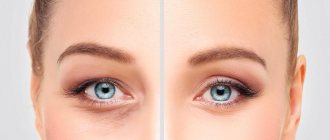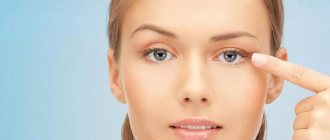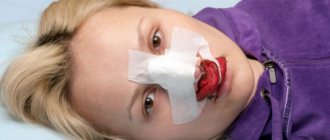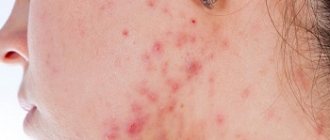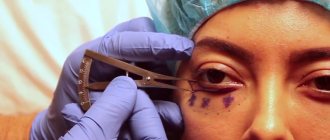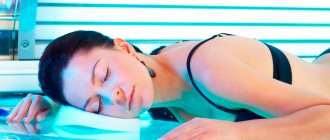Side effects of Botox and Dysport
Popular global companies of beauty cocktails, throughout their existence, have been collecting statistical data according to which not a single life-threatening complication has been diagnosed, caused by the use of products in the dose recommended for injection cosmetology. However, even those consequences that pharmacological giants consider “safe” can seriously ruin your life and lead to nervous exhaustion.
All adverse events caused by injections of beauty capsules can be divided into several main groups:
- Incorrect technique and tactics for introducing the concentrate and the very fact of puncture;
- Negative reactions to the introduced components.
The first group includes minor pain, hematomas, excess fluid accumulation and red lesions that occur due to damage to tissues and blood vessels during the procedure. During unskilled performance of the procedure, toxins may be incorrectly distributed along the facial fibers, as a result of which a violation of symmetry is often observed. You can get rid of this consequence only after complete or partial removal of toxins from the tissues.
The second group occurs with the entry of a neurotoxin into the body, regardless of how the work was carried out by cosmetologists.
The most common are:
- Migraine;
- Formation of “creases” in the eye area, on the forehead;
- Accumulation of fluid in tissues, formation of pimples;
- drooping eyebrows;
- Blurred picture in the eyes, splitting of objects;
- Impaired jaw function.
Hematomas and hemorrhages: a classic response to skin trauma
Doctors try to use the thinnest possible needles, despite this, it is almost impossible to avoid deformation of thin vessels. A hematoma, at best, will look like minor spots of blue and red color, at worst - voluminous dark subcutaneous circles.
Like many other complications, these symptoms are temporary and last no longer than a week. To prevent this situation from occurring, it is necessary to take medications that strengthen the vascular walls a few days before the procedure.
Migraine
This side effect is the most common and appears immediately after injections or a few days later. This can be explained by the body's protective reaction to injury. Women do not always observe restrictions during recovery, for example, allowing themselves a glass of wine.
Migraine is explained by numbness of a muscle group, others begin to work with double strength, maintaining the classic symmetry of the face. This phenomenon occurs due to persistent pain that persists until the tissues get used to the new load and begin to distribute it correctly. In any of the situations described, the tissues must recover within a few days, so the negative consequences will quickly dry up. Unpleasant symptoms can be easily relieved with pharmacological agents or by applying pressure to acupuncture points.
Wrinkles in the form of compensations and creases
Another negative point that appears when neighboring muscles must take over the work of paralyzed muscles. This entails a change in vector tension, which often leads to the formation of a number of irregularities in places that were not previously actively involved in facial expressions. Usually these are the lateral frontal areas.
Two weeks after the final absorption of all nutrients, the tissues will get used to the new volume work, all the folds that appeared as compensation will disappear naturally.
Compensation can be easily corrected with auxiliary injections of neurotoxin or using non-sulfonated glycosaminoglycan fillers - therefore, 14 days after exposure, the cosmetologist books the patient for a routine examination. Based on its results, a minor corrective lift is performed. But, in rare cases, even new injections are ineffective - in this case, the woman must wait patiently until the paralyzed muscles begin to work normally again.
Summing up
In principle, even a non-specialist can distinguish ordinary traumatic edema, formed as a result of trauma to the skin with a needle during injection, from complicated, pathological ones. Severe redness, thickening, soreness - all this is a reason for alarm and an emergency visit to the doctor.
According to patient reviews, complications after Botox in this form are quite rare, if the procedure was carried out correctly and the patient followed all the recommendations received from the doctor. In the photo taken just a few days after the successful correction of wrinkles, you can see the complete absence of swelling and signs of inflammation of the eyelids. If your face remains puffy and your eyelids are swollen, you should visit a cosmetologist rather than try to remove them yourself.
Botulinum toxin injections to smooth out wrinkles from year to year remain the most popular service in aesthetic cosmetology, not only among women, but also among men. That is why all their side effects deserve special attention.
Swelling after Botox, Dysport or another similar drug can negate the entire positive effect of the procedure and will remain a reminder for a long time of a failed attempt to erase the first age-related changes from the face.
Why do they occur, how long do they last, and in what cases should you sound the alarm? What to do with “swollen” upper eyelids and eyes? TecRussia.ru understands all the nuances of the problem, and eminent metropolitan cosmetologists share their own experience:
Risk factors: what you should warn your doctor about at the first consultation
Not every swelling is considered a complication/side effect of Botox or Dysport injections. In the simplest case, this is a completely normal reaction of the body to damage received from the insertion of a needle. Already on the first day it begins to subside and disappears without a trace within 2-3 days after the procedure.
More serious lymphostasis (caused by disturbances in the circulation of lymph and venous blood) edema appears on the 7th–10th day - at the time when the drug “gets up”, that is, it begins to immobilize the muscles. They can last from 1-2 weeks to two or more months and require special procedures in order to quickly return a healthy appearance to the face. The main diseases and conditions of the patient’s body, which are very likely to provoke the formation of problematic swelling after botulinum toxin injections:
- diseases of the liver, kidneys, cardiovascular system;
- fatty hernias of the eyelids;
- early recovery period after plastic or other surgical surgery;
- individual predisposition;
You should definitely inform your cosmetologist about all these nuances, who will advise the necessary preventive measures or suggest refraining from the procedure for a certain time.
Mechanisms of edema formation after “beauty injections”
For normal provision of tissues with nutrients and oxygen, timely removal of cell metabolic products, it is necessary that the blood supply, outflow of venous blood and lymphatic drainage be balanced. The flow of arterial blood is carried out due to the work of the heart. The outflow of venous blood, as well as lymphatic drainage, is stimulated by the following actions:
- during inhalation, negative pressure is created in the chest cavity, due to which air enters the lungs, venous blood and lymph enter the heart;
- during muscle contractions, venous blood and lymph are “pushed” through the vessels to the heart.
The balance between fluid entry into tissues and its removal may be disrupted:
- decreased muscle tone and contractility;
- the presence of diseases of the cardiovascular system, kidneys;
- hormonal imbalance in the body, etc.
In each of these cases, the development of problematic swelling is very likely. Let's take a closer look at why this happens and what the role of botulinum toxin is:
- The influence of muscle tone on the development of edema
When Botox or Dysport is administered, paralyzed muscles in the target subcutaneous areas stop contracting, which in some cases can lead to stagnation of venous blood and lymph in the tissues. In this case, swelling most often forms around the eyes, most often on the upper eyelids. This is due to the structural features of the skin - here it is thinner than in other areas of the face, does not have a supporting bone frame, and lies on a layer of loose fatty tissue. And small venous vessels, which are located in the eyelid area, are easily pinched by edematous tissue.
As a result, a “vicious circle” is formed: the greater the swelling, the worse the further outflow of venous blood and lymph. In particularly complex cases, the described mechanism can lead to the formation of persistent or persistent (occurring from time to time) swelling of the upper and/or lower eyelids, and sometimes of the entire face.
- Impact of diseases of the cardiovascular and urinary systems
The development of heart failure leads to a decrease in the heart's ability to pump blood through the vessels. This leads to overflow of the venous bed. In this case, part of the blood seeps into the tissues and accumulates there. Swelling forms, which appears from time to time, but can be permanent.
They appear on the legs and rise higher as heart problems develop. What does this have to do with face? It turns out that it is direct. Any exposure that would not cause adverse changes in a healthy person may lead to complications in a patient with heart failure. If the outflow of venous blood is already weakened, after injections of Botox, Dysport or another similar drug, muscle inactivity can lead to swelling of the upper eyelids and the face as a whole.
With most diseases of the urinary system, the ability of the kidneys to remove excess fluid and mineral salts is reduced to some extent. The latter “settle” in the tissues, which also leads to the formation of edema. With kidney failure, swelling most often appears in the face. If you “turn off” the auxiliary effect of muscle contractions on the outflow of venous blood and lymph, they become stronger and more noticeable.
- Impact of hormonal imbalance
The ability of tissues to retain fluid is influenced by female sex hormones. For many, mild facial swelling may appear on certain days of the menstrual cycle. Almost all pregnant women experience swelling. If before the onset of menstruation the face becomes puffy, then the risk of similar problems appearing after anti-aging injections is also very high.
Drug treatment
If your eyelids droop after Dysport, the use of medications will help reduce the symptoms:
- Eye drops, erythromycin or tetracycline ointments;
- Vitamin tablets with enhanced formula of group B;
- Injections of proserin, neuromedian;
- Mesotherapy - the use of threads or mixtures of hyaluron, phospholipids, polylactic acids, microelements.
All the means used have a targeted effect on restoring the mobility of muscle tissue, eliminating asymmetry, increasing the breakdown of the neurotoxin and reducing the time it takes to eliminate it.
In especially severe cases, the complication is corrected through surgery.
Treatment of the disease
Most often, ptosis of the upper eyelid, which occurs after Botox injection, does not require any special treatment and goes away on its own within 1-2 months. To speed up the removal of botulinum toxin from the body, additional treatment may be carried out.
Conservative treatment
The main goal of conservative treatment is to restore the functionality of the damaged nerve and is used when a neurogenic form of ptosis is diagnosed after Botox injection. Treatment of the disease is carried out using the following methods:
- face massage;
- conducting local UHF therapy;
- the patch is used to fix the upper eyelid;
- carrying out a procedure such as galvanotherapy, which uses galvanic current;
- laser therapy;
- electrophoresis.
Surgery
Treatment of the disease with surgery is used when it is not possible to achieve a positive result with conservative treatment methods and ptosis of the upper eyelid after the administration of Botox develops into a severe form.
Timely and high-quality treatment will help save the patient from further progression of severe complications and restore the damaged upper eyelid muscle through surgery.
Features of the operation
If ptosis of the upper eyelid is diagnosed after Botox injection, a decision is made to perform surgery, all efforts are directed towards shortening the aponeurosis of the upper eyelid muscle.
The operation is performed under local or general anesthesia and its duration ranges from 30 to 50 minutes. After it, no traces of scars remain on the facial skin, since the wound is sutured using cosmetic sutures and they are removed seven days after the operation.
Most often, there is no need to take analgesics, since the wound does not cause any severe pain. After the operation, a sterile bandage is applied to the resulting wound, which is removed after a few hours.
Types of surgery
All operations can be divided into several types:
- Eversbush's operation is one of the most common types of surgical intervention, which involves the formation of a fold on the levator tendon;
- Mote technique - this operation is the most complex type of surgical intervention and not all cosmetology clinics undertake it. Its essence lies in strengthening the levator function with the help of the upper muscle in the absence of its paralysis;
- Hess operation - this surgical intervention is performed in the presence of levator and superior rectus palsy. In this case, suturing is performed with the transfer of the levator function to the frontal muscle.
Upper eyelid ptosis is one of the unpleasant eye pathologies that can develop after Botox injections. To prevent this disease, it is recommended to carry out procedures using bototoxin preparations only under the supervision of experienced specialists and in specialized clinics. Treatment of lower eyelid ptosis in the early stages of its development will avoid serious complications in the future.
Edema
Another very common complication after injections of Botox, Dysport, Xeomin is swelling. This is excessive accumulation of fluid in the subcutaneous space.
Manifestations
Edema manifests itself in the form of noticeable swelling, “swollen” areas or “bags” under the eyes.
Swelling after injections can occur in different areas of the face: around the eyes, on the forehead, in the eyebrow fold near the lips. Most often, severe swelling is observed on the upper eyelids
, since the skin is thinnest here, and the muscles that support it do not have a bone frame.
Causes
The procedure ensures smoothing of wrinkles, which occurs by blocking the motor nerves. This leads to relaxation of the facial muscles and their partial paralysis. Thus, the number of muscle contractions is significantly reduced and the skin is gradually smoothed out. However, as a result of this, other physiological processes in the subcutaneous layers are also disrupted. The main reason why edema appears is that immobilization of muscles provokes stagnation of venous blood and lymphatic fluid in the tissues. Such difficulties with microcurrents inevitably lead to increased swelling.
In general, slight swelling is a natural reaction to the injection. A puncture even with a very thin needle leads to disruption of the integrity of the skin and damage to the walls of blood vessels, as a result of which redness and slight swelling appear in this area. In this case, these defects quickly disappear without any special procedures.
But there are other reasons why swelling appears after injections of Botox, Dysport and Xeomin:
- incorrectly selected injection points;
- drug overdose;
- failure to comply with disinfection rules during the procedure;
- improper distribution of the drug under the skin.
Also, the occurrence of edema can be provoked by the patient himself, if
:
- rub your face and puncture sites;
- tilt;
- be exposed to high temperatures;
- drinking alcohol;
- eat foods that help retain fluid in the body;
- take antibiotics.
Edema may occur if the patient has:
- allergy to the drug;
- decreased muscle tone;
- tendency to edema;
- cardiovascular diseases;
- problems with the urinary system;
- hormonal disorders;
- weakened immune system;
- liver diseases.
Therefore, the first thing a patient should do when planning to undergo anti-aging procedures is to undergo an examination and pass the necessary tests.
When will the swelling go away?
The reason that caused the swelling depends on how long it will last. If this is a normal reaction to an injection, then after 3-4 days the swelling will disappear. The swelling that appears as a result of the action of the drug becomes noticeable only 8–11 days after the procedure and within two months goes away on its own as the effectiveness of the injected substance weakens. If such side effects occur against the background of existing diseases in the patient, complex therapy will be required.
Treatment
Recommendations on what to do and how to remove swelling depend on the root cause of its formation. In the first case, it is enough to be careful and wait a little. If serious systemic complications occur and radical measures are required, hospitalization is not excluded.
Let us dwell in more detail on the elimination of edema resulting from the unprofessional actions of a doctor or improper behavior of the patient. In such a situation it is necessary:
- intensify metabolism to speed up the removal of botulinum toxin from the body;
- use diuretics;
- improve drainage of the inner layers of the dermis.
In order to quickly get rid of edema, it is recommended:
- reduce the amount of fluid consumed;
- take a course of decoctions of diuretic herbs;
- take a course of professional lymphatic drainage massage;
- make regenerating face masks and warm compresses;
- take diuretics.
You can find advice that states that to relieve swelling you should take succinic acid (in capsules or by injection) and vitamin E.
Development of ptosis after Botox injections
Botox injections, gaining more and more popularity year after year, are considered by many people as one of the best ways to deal with wrinkles around the eyes when conventional cosmetics no longer bring the desired results. The principle of their action is as follows: after examining the eyelids, a specialist identifies so-called areas of muscle hyperactivity, which relax after injections, due to which the skin around the eyes is smoothed.
However, procedures of this kind have many side effects, which can be quite dangerous to health if ignored. Often one of these possible complications is ptosis of the upper eyelid. This problem most often arises as a result of mistakes made during the injections themselves or incorrect calculation of the dosage of the injected substance, that is, the main reason for the drooping of the upper eyelid after Botox can, first of all, be called the low qualifications of the specialist performing the procedure. In this case, the muscle that is responsible for raising the upper eyelid loses strength and ability to perform its functions.
According to statistics, among all the adverse results of Botox injections, cases of ptosis of the upper eyelid account for at least 20% of the total. But, due to the fact that the effect of the procedure itself is time-limited, this complication gradually disappears even without special therapy. As a rule, signs of drooping eyelids persist for no longer than a month from the date of drug administration. However, it should be taken into account that if there is ptosis of the eyelids even before the procedure, after Botox injections the situation can worsen significantly, which experts do not always warn about in advance.
In any case, drooping eyelids is a pathology that can and is extremely important to treat, for which modern medicine has many effective methods, starting with medications, massage and special exercises and ending with surgery. And the sooner and more accurately the causes of the pathology are determined, the higher the likelihood of getting rid of it or slowing down the process of its development.
Swelling in normal and pathological conditions
After Botox, facial muscles lose their contractility. They become immobilized, venous and lymphatic outflow is disrupted, since these vessels do not have their own pronounced valve apparatus that pushes blood and lymph.
The appearance of swelling in such a situation is normal. His condition should be monitored. The swelling should decrease rather than increase, disappearing after three days.
Side effects occur after 72 hours or immediately with pronounced swelling, redness, itching and pain may be disturbing. This occurs from severe stagnation of lymph, compression of nerve endings, and penetration of biologically active substances from the body that promote inflammation.
Indications for Dysport injections
Unfortunately, practice has shown that even surgical facial plastic surgery does not eliminate the appearance of “crow’s feet” and facial wrinkles. It is small, medium and deep wrinkles that begin to change our face beyond recognition, making its expression tired and older. A worthy alternative to surgery are Dysport injections, which have long been used in cosmetology practice to quickly eliminate wrinkles.
MORE ABOUT: How to relieve swelling and swelling from a bruise from an impact?
Thanks to this, for a certain period of time the muscles are in a state of flaccid paralysis, and wrinkles simply disappear for some time. After injections, a person cannot frown or squint as before. Typically, the effect of botulinum toxin lasts from 6-8 to 10-12 months. The duration of the effect depends on the number of injections and the type of drugs that are injected into the muscle tissue according to indications. Microinjections of Dysport into the corrected areas do not cause loss of skin sensitivity.
Dysport is an excellent, unparalleled remedy for wrinkles in the bridge of the nose, forehead and small wrinkles around the eyes associated with facial emotional manifestations. Everyone knows that expression wrinkles can appear on the face quite early, since excessive mobility of the facial muscles, which is genetically determined, is quite common. Often, a visit to a cosmetologist is associated precisely with the appearance of wrinkles. To eliminate them, cosmetologists recommend Dysport or Botox.
Questions about which drug is better - Botox or Dysport - are encountered quite often. In fact, the active ingredient in these drugs is the same - botulinum toxin type A, only Botox is produced in the USA, and Dysport is produced in France. Each botulinum toxin preparation has a unique formula and clinical profile, and doses of one drug cannot be converted to doses of another. There are significant differences between Dysport and Botox in therapeutic dosages, dose/effect ratios, antigenic potentials, and safety profiles.
The drug is administered via intramuscular injection. The procedure does not take much time, but before it is carried out, a detailed conversation with a doctor is necessary to identify indications for drug injections.
What it is?
- Definition . Edema is an excessive accumulation of fluid in the space under the skin, due to impaired outflow and fluid retention in the tissues.
- Places of origin . Swelling can appear in different parts of the face: near the lips, on the forehead, around the eyes, in the eyebrow area. Most often they form under the eyes. You can learn about Botox in the lip area here, and read about the procedure for the forehead here.
Under the influence of botulinum toxin, temporary paralysis and relaxation of the muscular system occurs. The muscles do not contract, venous blood stagnates in the vessels, and the outflow of lymph in the tissues becomes difficult.
Diagnostics
Ophthalmology diagnoses ptosis by conducting the following studies:
- measuring the height of the upper eyelid;
- at the moment of blinking, they study whether the skin folds are symmetrical or not;
- measure muscle tone;
- the neuropathologist makes his conclusion;
- electromyography of the muscle is performed;
- Brain MRI;
- Ultrasound of the eyes;
- X-ray of the orbit, autorefractometry;
- perimetry;
- measure the angle of biological strabismus;
- study convergence;
- Binocular vision is checked.
Of course, an ophthalmologist will not do all of the above tests. He performs an external examination, prescribes tests and directs some diagnostic tests that will help make the most accurate diagnosis and choose the right treatment.
Drooping eyelid: causes and symptoms
Botox injections are most often done in the upper part of the face. In this way it is easy to get rid of crow's feet, eyebrow folds and deep horizontal wrinkles on the forehead. And, contrary to the popular belief that ptosis of the upper eyelid occurs only after Botox injected into the area around the eyes, this complication also occurs in other cases.
Main reasons
The most common causes of side effects are:
- Unprofessionalism. Of course, there are certain methods for administering drugs by zone. But an experienced doctor knows that control points are quite conditional. Having a good understanding of facial anatomy, he will adjust injection sites based on the individual characteristics of the patient.
- Choice of drug. The concentration of neutoroxin in different drugs is not the same. They also have the property of diffuseness - the ability to penetrate into neighboring tissues. For example, with Dysport it is significantly higher than with the original Botox, and when the same number of units is administered, the likelihood of developing ptosis in the first case is higher.
- Individual reaction. Sometimes it can be unpredictable. In people with hypersensitivity to the drug, ptosis may develop even after administration of the minimum dosage. There is also such a thing as a cumulative effect. Repeating the procedure many times increases the risk of eyebrow drooping.
- Overdose. Lately, this has been happening not only to young professionals. Today, a new trend is rapidly developing - to work with inflated doses of the drug during the initial administration. This really allows you to quickly get excellent results, but increases the risk of complications.
- Damage to the facial nerve. When a neurotoxin is injected deeply, there is a risk of damage to the facial nerve. This can lead not only to noticeably drooping eyebrows after Botox injections, but also to paresis of the facial muscles, in which it turns into an asymmetrical mask.
In fact, one way or another, responsibility for the negative consequences of “beauty injections” lies mostly with the cosmetologist
This is why it is so important to get into the hands of a good specialist, even if the price of the procedure in this case will be higher
Types of ptosis
Depending on the severity, experts divide ptosis of the upper eyelid into:
- light – drooping is almost invisible visually, the eyelid slightly covers the upper part of the pupil;
- incomplete – the skin fold covers up to half the pupil;
- full - the eye is completely closed, and it is impossible to lift the eyelid without the help of hands.
Unpleasant consequences
In fact, the situation when after Botox the eyelids droop and the eyes are almost completely closed is extremely rare. But even mild forms of ptosis can provoke rather unpleasant consequences:
- Noticeable facial asymmetry, often accompanied by drooping of one of the eyebrows. This problem mainly causes moral discomfort.
- Drying of the cornea. Due to severe relaxation of the muscles around the eyes, blinking function is impaired. The cornea is not sufficiently moisturized and begins to dry out, which causes irritation and a constant feeling of itching.
- Problems closing the eyes. Most often they occur with incomplete ptosis. This interferes with a good night's rest and greatly irritates patients.
- Neck muscle strain. To have a normal view, patients with ptosis begin to tilt their heads back. This can provoke neck pain and exacerbation of osteochondrosis.
- Tearing and/or swelling. Appear when the normal outflow of fluid is impaired due to weakening of the orbicularis ocular muscles.
Although none of these problems pose a real threat to the patient’s health and life, each of them causes severe discomfort and requires correction.
Causes
Wrong rehabilitation
Swelling may occur if the patient does not comply with the doctor’s instructions:
- For a couple of hours after the procedure, you need to maintain a horizontal position, do not lower your head, bend over or lie down. It is not recommended to sleep in a position facing the pillow. It is better to sleep on several pillows, with your head elevated.
- Already two days before the procedure and at least two weeks after, it is necessary to completely eliminate alcohol. A minimal dose of alcohol can cause swelling.
- At first, it is advisable to reduce water consumption, especially in the evening and at night.
- After the procedure, for two weeks, it is important to carefully monitor your diet. Avoid spicy, salty and fatty foods. Such foods retain water in the muscles, which leads to swelling.
- Avoid mechanical impact on facial skin.
For two weeks, it is necessary to exclude temperature changes and thermal effects on the skin of the face. You should refrain from visiting baths, saunas, and do not actively sunbathe or visit solariums. The use of warming masks and steaming of the facial skin is unacceptable . You can read why visiting bathhouses and saunas is prohibited here.
Read more about what you can and cannot do after Botox in this article.
Doctor's mistakes
A doctor’s mistake during the procedure, as a result of his low qualifications, can also lead to the appearance of edema:
- Incorrectly chosen injection site, incorrect calculation of the dosage of the drug.
- The point for Botox injection is incorrectly determined. As a result, improper distribution of the drug in tissues occurs, which leads to complications. When performing an injection in the lower eyelid area, it is important to remember that the drug must be administered only subcutaneously; injecting Botox intramuscularly will cause complications. And the dosage of the drug in this case will be minimal.
- A competent specialist begins the injection with a small amount of botulinum toxin. And only when a satisfactory result is obtained, he will add a few additional units of the drug.
How to prevent drooping eyelids after the procedure
In order for the procedure to bring the desired effect and not spoil the appearance, it is important to pay attention to many subtleties and nuances. To begin with, you should remember that applying Botox around the eyes (for crow's feet) and on the forehead (less often) carries the risk of drooping eyelids or eyebrows, and you need to be prepared for this. There is always a risk that something will go wrong, but it can be reduced
There is always a risk that something will go wrong, but it can be reduced.
To begin with, you need to carefully consider the choice of clinic and specialist. For those who have decided to undergo the procedure for the first time, it is useful to read reviews or ask the opinions of those who have already done the procedure. Those who are doing Botox not for the first time already have experience communicating with doctors, and should contact their trusted cosmetologist.
A good cosmetologist understands that the facial structure has many individual characteristics, and there is no universal scheme that gives the right result for all patients. The drug is administered at strictly defined points, which are calculated anew each time for each patient. Correct administration of the drug and accurate dosage calculations can reduce the risk of undesirable consequences.
The procedure itself takes a little time, but after it the recovery period lasts about a day. During this time, botulinum toxin can move from the place where it was injected to neighboring areas. To avoid this, you must observe a number of restrictions:
- For the first 2-3 hours after surgery, you need to monitor your facial expressions. It is especially dangerous to squint around the eyes after Botox. You need to take sunglasses with you to the procedure, even if the weather outside is cloudy. Those who have vision problems should wear glasses and avoid contact lenses for a while;
- At the same time, you should not touch your face, especially the area where the procedure was performed;
- You should not do any activities that require working in an inclined position (washing the floor, etc.);
- It is better to sleep 4-5 hours after Botox, in a supine position. There is no need to lower your face;
- It is advisable to refrain from using cosmetics for 24 hours after the procedure; you can use care products in neighboring areas, but without touching the area where the injections were performed.
When performing the procedure, the doctor will explain all these subtleties and give recommendations on how to ensure that the drug remains in the same place where it was injected. After Botox, you will feel discomfort for some time, what is especially unpleasant is that the skin will itch, and it is undesirable to scratch it.
There may be slight redness and swelling at the injection sites, which will subside within a few hours or a day at most. If pain occurs, and external changes do not go away, but progress, you need to consult a doctor - this is a sign of dangerous processes occurring in the skin.
Harm of Botox
Features of Botox
To improve their appearance, women decide to undergo botulinum toxin injections. In many cases, it is actually possible to hide the natural signs of tissue aging for a short time. The procedure for administering this drug is widespread today; a huge number of aging women manage to undergo it repeatedly and without side effects. When considering medical statistics from around the world, it becomes clear that in some cases there are indeed unwanted consequences of this simple operation. If swelling under the eyes has formed after Botox, then you need to find out the cause as quickly as possible by going to the clinic where the drug was administered.
Side effects of Botox
Specialist mistakes
If the drug is administered incorrectly, patients experience unpleasant symptoms, these include pain of various types, the appearance of hematomas, severe or subtle swelling, and skin hyperemia. The most frightening manifestation of errors when introducing botulinum toxin is facial asymmetry, which is formed due to the uneven distribution of the drug in the thickness of the tissues. The described problems are observed against the background of damage to the walls of blood vessels and in most cases are temporary. In the best case, after a week the tissues are properly regenerated, and the negative effects of Botox are somewhat reduced.
Specific reaction of the body to Botox
A negative perception of the drug by the body can be recognized by headaches, dizziness, muscle weakness, disruptions in the digestive system, and lacrimation. Practice has shown that individual intolerance to Botox often leads to eyelid ptosis. Visually noticeable changes, expressed in drooping of the upper eyelid, occur in 1% of all patients undergoing the procedure. Experts assure all victims that after 3 months the tone in the eyelid muscles is naturally restored, and the eyes return to their original place. Whether this is really so can be found out in practice.
Patient misbehavior
It should be noted that an impressive part of unexpected phenomena after beauty injections are due to the fault of the patients themselves. The fact is that individuals consider generally accepted safety rules and medical recommendations to be insignificant. At the same time, all patients of cosmetology clinics are informed about what actions after the procedure may be dangerous, and are also notified of the presence of contraindications. Clients who neglect the established rules often experience ptosis, asymmetry, swelling and other bad consequences. It is known that during the rehabilitation period it is harmful to take any alcohol, bend over, engage in intense sports, expose the body to sudden changes in temperature, take drugs from the group of aminoglycosides, and also mechanically influence the treated area. These are only the main contraindications; other factors may also occur, so a detailed individual consultation is required.
During a preliminary conversation with a specialist, it is worth giving complete information about yourself, indicating the medications you take, the cosmetics you use and any chronic diseases you have.
In this way, the likelihood of botulinum toxin failure can be reduced. Swelling under the eyes:
a consequence of improper patient behavior, injection errors or drug overdose
Types of threads for lifting
There are many types of threads for eyebrow lifting. But the best ones are considered to be Aptos, Mesothreads and gold ones. Each type has its positive and negative sides. Therefore, it is best to entrust the choice of material to a beauty specialist, who must take into account the client’s preferences.
The main differences between Aptos, Golden and Mesothread threads:
- Aptos began to be used not so long ago. Aptos are made from unique suture materials and have a serrated shape, allowing them to penetrate deep into the skin. Unlike other types, they do not dissolve and when inserted they connect with internal tissues. Thus, not only the top layer, but also the subcutaneous layer is leveled. Since they do not dissolve, they are overgrown with a layer of new cells, forming a dense framework. Because of this, the skin will be smooth for a long time, up to 3 years. Aptos threads have only one drawback: a repeated procedure can cause difficulties, since there will already be a dense framework under the skin.
- Gold threads have another name - platinum. Eyebrow lifting with gold threads was popular in the second half of the 20th century, and currently they have not lost their popularity. Since gold does not oxidize and has a rejuvenating effect. In order for the fishing line to pass freely under the skin, it is coated with polyglycolic acid. Brow lifting with gold threads guarantees a long-lasting effect that lasts from 5 to 10 years. The disadvantage of these threads is that after using them, any procedures using a laser are prohibited.
- And another most common material is mesothreads. Most often, they are recommended for women undergoing a brow lift for the first time or for young girls. Since they are very flexible and delicate, unlike other types, they are easily fixed and completely disappear over time. They give the same effect as Aptos threads; they also smooth the skin in the eye area, forehead, and lift the eyebrows and eyelids. After their introduction, a temporary frame is formed, which is overgrown with cells, after which the material disappears. Thus, the material is completely absorbed, leaving no trace 3 years after the operation, so any other operations and interventions are not prohibited. However, these threads are not suitable for women over 50 years old, as they only level the top layer and will not bring the desired result.
About lifting the upper eyelids with threads >>
These types of threads are the most common and effective. A lot when choosing threads depends on the age and skin type. But you should always give preference to quality materials. Therefore, it is best to contact only experienced specialists. Using low-quality material and lack of experience can lead to dire consequences.
If you hit a nerve with Botox injections
If you hit a nerve with Botox injections, the consequences may be as follows:
- the eye begins to twitch, namely the upper or lower eyelid - depending on which nerve the doctor hit,
- the face becomes distorted.
The problem can be solved by visiting a neurologist, who will determine the degree of nerve damage and prescribe adequate therapy to restore health.
If the procedure was performed correctly, then this is simply impossible - the doctor must perfectly know the human anatomy and understand where the nerves pass. Injections can only affect those nerves that are located close to the dermis - facial, trigeminal. The visual one is located very deep, so it is not damaged.
